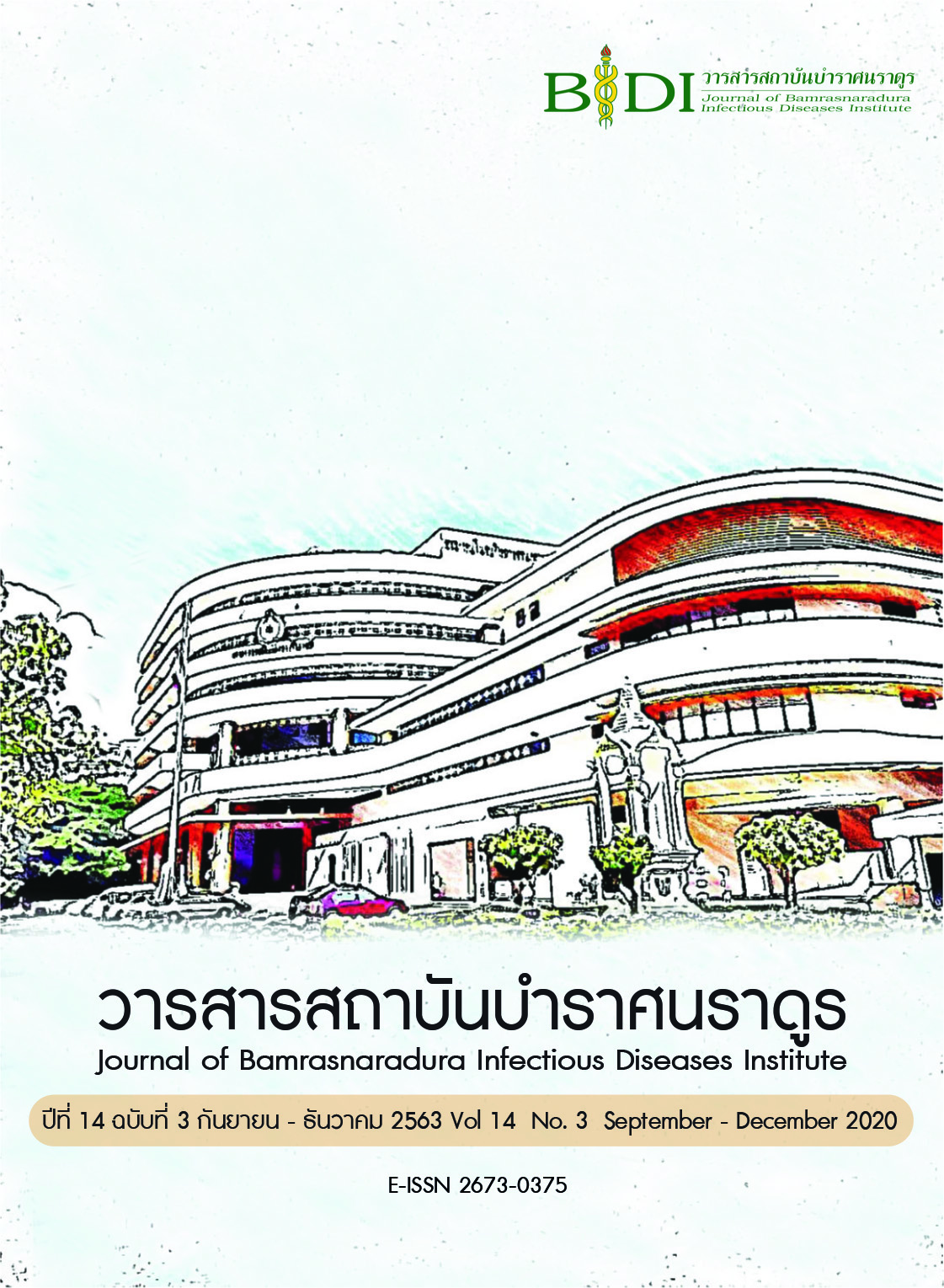ปัจจัยทำนายพฤติกรรมการจัดการตนเองของเด็กที่ป่วยด้วยโรคธาลัสซีเมีย
Main Article Content
บทคัดย่อ
การวิจัยเชิงทำนายนี้ มีวัตถุประสงค์เพื่อศึกษาพฤติกรรม และปัจจัยทำนายพฤติกรรมการจัดการตนเองของเด็กที่ป่วยด้วยโรคธาลัสซีเมีย กลุ่มตัวอย่างเป็นเด็กวัยเรียนที่ป่วยด้วยโรคธาลัสซีเมียที่มารับบริการที่คลินิกโรคเลือด และหอผู้ป่วยกุมารเวชกรรม โรงพยาบาลชลบุรี และมีคุณสมบัติตามที่กำหนดไว้ จำนวน 88 คน เครื่องมือที่ใช้ในการวิจัยประกอบด้วยแบบประเมินและแบบสอบถามการบริหารจัดการด้วยตนเอง ทั้งหมด 3 ส่วน ได้แก่ 1) แบบประเมินความรอบรู้ด้านสุขภาพ 2) แบบสอบถามความร่วมมือในการรักษา และ 3) แบบสอบถามพฤติกรรมการจัดการตนเองเด็กที่ป่วยด้วยโรคธาลัสซีเมีย ซึ่งมีค่าความเชื่อมั่นเท่ากับ 0.93, 0.94 และ 0.82 ตามลำดับ วิเคราะห์ข้อมูลโดยใช้สถิติเชิงบรรยาย สัมประสิทธิ์สหสัมพันธ์ของเพียร์สัน และสถิติวิเคราะห์ถดถอยพหุแบบขั้นตอน
ผลการศึกษาพบว่า คะแนนเฉลี่ยพฤติกรรมการจัดการตนเองโดยรวมอยู่ในระดับปานกลาง ( = 143.8, SD = 13.30) เมื่อพิจารณาเป็นรายด้านพบว่า คะแนนเฉลี่ยด้านการรักษาและด้านบทบาทหน้าที่อยู่ในระดับปานกลาง ส่วนด้านจิตสังคมอยู่ในระดับสูง ปัจจัยทำนายพฤติกรรมการจัดการตนเอง ได้แก่ ความร่วมมือในการรักษา และความรอบรู้ด้านสุขภาพ สามารถร่วมกันทำนายได้ร้อยละ 17.4 (p-value < 0.001) โดยความร่วมมือในการรักษาเป็นตัวแปรที่สามารถทำนายพฤติกรรมการจัดการตนเองได้อย่างมีนัยสำคัญมากที่สุด (β = 0.297, p-value = 0.004) รองลงมาคือ ความรอบรู้ด้านสุขภาพ (β = 0.292, p-value = 0.005) แสดงให้เห็นว่า การจัดโปรแกรมที่เหมาะสมควรเพิ่มความร่วมมือในการรักษาและความรอบรู้ด้านสุขภาพเพื่อเพิ่มพฤติกรรมการจัดการตนเองของ
เด็กวัยเรียนโรคธาลัสซีเมีย
Article Details
เอกสารอ้างอิง
Weatherall DJ. Thalassemia as a global health problem: recent progress toward its control in the developing countries. Ann NY Acad Sci 2010 Aug 2; 1202(1): 17-23. doi: 10.1111/j.1749-6632.2010.05546.x. PMID: 20712767.
Ministry of Public Health. Thalassemia [internet]. 2018 [cited 2020 Mar 12]. Available from: https://pr.moph.go.th/?url=pr/detail/all/02/116500. (in Thai)
Viprekasit V. Comprehensive management for thalassemia. J Hematol Transfus Med 2013; 23(4): 303-20. (in Thai)
Wacharasin J, Paktoop M, Sananreangsak S, Teerarungsikul N, Tunsawad T. Evidence, problems, impact and empowerment in family caregiver of chronically ill children. Journal of Public Health Nursing 2008; 22(3): 25-39. (in Thai).
Medical Statistics, ChonBuri Hospital. Medical statistics report. Chon Buri: Medical Records Department ChonBuri Hospital; 2019. (in Thai)
Teerarungsikul N, Sananreangsak S. Self-management experiences of children with thalassemia. JFONUBUU 2015; 23(4): 48-60. (in Thai)
Kuttarasang R, Sananreangsak S, Teerarungsikul N. Effect of family management promotion program on maternal management and health status of school-age children with thalassemia. TJN 2017; 66(3): 1-10. (in Thai)
Imiwat M. The effects of the health education program on health behavior development of thalassemia children. Rajabhat Chiang Mai Research Journal 2012; 13(1): 115-28. (in Thai)
Hockenberry MJ, Wilson D. Wong’s nursing care of infants and children. 10th ed. St. Louis: Missouri; 2015.
Klunklin P. Nursing care of children for health promotion. Chiang mai: Smartcoating and Service; 2017. (in Thai)
Lorig KR, Holman HR. Self-management education: History, definition, outcomes, and mechanisms. Ann Behav Med 2003 Aug 1; 26(1): 1-7. doi: 10.1207/S15324796ABM2601_01. PMID: 12867348.
Grey M, Knafl K, McCorkle R. A framework for the study of self- and family management of chronic conditions. Nurs Outlook 2006 Sep 1; 54(5): 278-86. doi: 10.1016/j.outlook.2006.06.004. PMID: 17027605.
Disler RT, Gallagher RD, Davidson PM. Factors influencing self-management in chronic obstructive pulmonary disease: An integrative review. International Journal of Nursing Studies 2012 Feb; 49(2): 230-42. doi: 10.1016/j.ijnurstu.2011.11.005. PMID: 22154095.
Hansen HR, Shneyderman Y, Belcastro PA. Investigating the association of health literacy with health knowledge and health behavior outcomes in a sample of urban community college undergraduates. American Journal of Health Education 2015 Aug 28; 46(5): 274-82. doi: 10.1080/19325037.2015.1055016.
Jebraeily M, Makhdoomi K. Factors influencing the improvement of self-management behavior inhemodialysis patient. J Nephropharmacol 2018 Jun; 7(2): 110-3. doi: 10.15171/npj.2018.23.
Berg CA, Butner JE, Turner SL, Lansing AH, Kong P, Wiebe DJ. Adolescents’, mothers’, and fathers’ reports of adherence across adolescence and their relation to HbA1C and daily blood glucose. J Behav Med 2016 Aug 8; 39(6): 1009-19. doi: 10.1007/s10865-016-9771-5.
Gonzalez JS, Tanenbaum ML, Commissariat PV. Psychosocial factors in medication adherence and diabetes self-management: Implications for research and practice. Am Psychol 2016 Oct; 71(7): 539-51. doi: 10.1037/a0040388. PMID: 27690483.
Sananreangsak S, Lapvongwatanal P, Virutsetazin K, Vatanasomboon P, Gaylord N. Predictors of family management behavior for children with thalassemia. Southeast Asian J Trop Med Public Health 2012 Jan; 43(1): 160-71. PMID: 23082567.
Yusuk P, Sananreangsak S, Teerarungsikul N. Factors related to maternal management for children with thalassemia. JOPN 2019; 11(1): 151-62. (in Thai)
Cohen J. Statistical power analysis for the behavioral sciences. 2nd ed. New Jersey: Lawrence Erlbaum Associated Publishers; 1988.
Davis TC, Wolf MS, Arnold CL, Byrd RS, Long SW, Springer T, et al. Development and validation of the Rapid Estimate of Adolescent literacy in Medicine (REALM-Teen): A tool to screen adolescents for below-grade reading in health care settings. Pediatrics 2006 Dec 1; 118(6): 1707-14. doi: 10.1542/peds.2006-1139.
Bloom BS, Hastings JT, Madaus GF. Handbook on formative and summative evaluation of student learning. New York: McGraw-Hill; 1971.
Tabachnick BG, Fidell LS. Using multivariate statistics. 7th ed. Boston: Pearson Education; 2013.
Bowden VR, Greenberg CS. Children and their families: The continuum of nursing care. 3rd ed. Philadelphia: Wolters Kluwer Health/Lippincott Williams & Wilkins; 2014.
Thavorncharoensap M, Torcharus K, Nuchprayoon I, Riewpaiboon A, Indaratna K, Ubol BO. Factors affecting health-related quality of life in Thai children with thalassemia. BMC Blood Disord 2010 Jan 21; 10: 1. doi: 10.1186/1471-2326-10-1. PMID: 20180983.
Sanguanpong Y, Angsupakorn N. The relationship between selected factors and self-care of school-aged thalassemic patients at Chaiyaphum Hospital. Journal of nursing science & health 2009; 32(1): 76-89. (in Thai)
Nutbeam D. Defining and measuring health literacy: What can we learn from literacy studies? Int J Public health 2009 Jul 30; 54(5): 303-5. doi: 10.1007/s00038-009-0050-x. PMID: 19641847.


